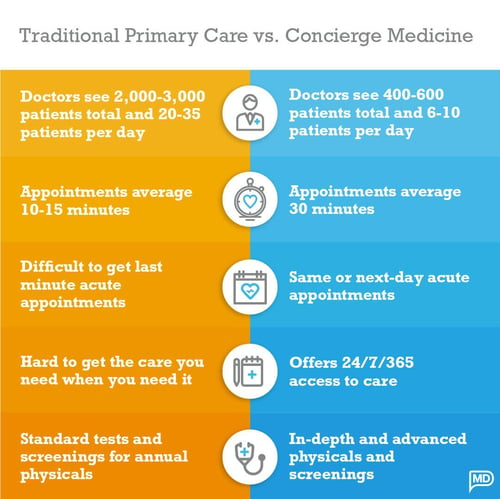March 2nd, 2023 | 4 min. read
Have questions about becoming a concierge doctor? Download our comprehensive guide to learn all you need to know.
Topics:
March 2nd, 2023 | 4 min. read

When exploring potential careers as a primary care doctor, you may stumble upon a debate between concierge medicine jobs and primary care jobs. What’s the difference?
The difference is not in the doctor. Within both, you will find doctors who strive to provide the best possible care to their patients.
The difference between a traditional primary care doctor and a concierge doctor is the structure in which they practice. There are five key differences in the way concierge doctors practice compared to traditional PCPs:
As a concierge medicine practice that has grown from one doctor in one office in 2003 to 30 doctors in seven offices today, we’ve talked to countless physicians about these differences.

Let’s explore each.
In traditional primary care, doctors often maintain a panel of 2,000-3,000 patients. And on any given day, they work through more than 20 appointments per day.
This is because traditional primary care practices make their revenue primarily through insurance reimbursements. To generate enough revenue to keep the lights on, they must see a lot of patients every day. It’s a necessity of the business model, not the care model.
In concierge medicine, a doctor’s panel size is often between 400-600 patients. And they see somewhere between 6-10 patients per day. This doesn't mean concierge doctors work less. That's one of the myths about becoming a concierge doctor. It simply means they work differently. With fewer patients on their schedule, they spend more time with each patient.
This is made possible through the annual membership fee that most concierge medicine practices charge their patients. The fee helps to offset some of the lost medical revenue from having a smaller panel size.
Because traditional primary care doctors see so many patients each day, it is difficult to spend significant time with everyone. The business day isn’t longer; doctors just have to squeeze more patients into it.
In 2016, Medscape’s Physician Compensation Report reported that the most common estimate for time spent with each patient was 13-16 minutes.
As a traditional practice physician, you might get to spend 15 minutes with a patient if you’re lucky, but that means you’re going to be rushing to your next patient and maybe only spend 7-10 minutes with them.
As a concierge doctor, because you only have 6-10 appointment slots per day, there is no need to rush. And your schedule is never double booked.
Most concierge practices guarantee appointments that last at least 30 minutes. The additional time creates an opportunity to truly get to know patients and establish long-term relationships.
It also allows concierge doctors to spend the time to figure out the root cause of issues, make connections between different health conditions, and avoid the whack-a-mole experience of giving care in a large-panel environment.
Small panels allow you to provide thorough care that you can be more confident in and reduce the fear of missing something because you’re rushing through 10-minute appointments all day. It's one of the primary benefits of becoming a concierge doctor.
/have-a-look-at-your-bloodwork-results-picture-id1293814791%20(1).jpg?width=1024&name=have-a-look-at-your-bloodwork-results-picture-id1293814791%20(1).jpg)
One thing we hear from traditional primary care doctors interested in switching to concierge medicine is that, because they have so many patients, their schedules are booked days or weeks in advance.
A 2017 study found the average wait time for a physician appointment in 15 large U.S. metro markets was 24.1 days. It leads to a situation where traditional PCPs can’t treat their patients in person when they’re ill. The schedule is too packed.
Instead, traditional primary care physicians attempt to treat patients over the phone quickly or advise them to head to urgent care. That’s not why they became doctors.
Most concierge practices guarantee same-day or next-day appointments for patients and dedicate time on their doctors’ schedules each day to see those acute care visits.
Concierge doctors can see a patient quickly, whether the patient starts to feel bad at work, after dinner, or in the middle of the night. There is less guesswork over the phone and less suggesting patients head to urgent care.

Illness doesn’t abide by business hours. People get sick after hours, on the weekends, while traveling, during holidays, and in the middle of the night.
At a traditional primary care practice, after the office closes for the night, there may be a nurse line or triage service, or doctors may encourage patients to leave a voicemail. It’s an impersonal system for situations where patients deserve personalized care.
Concierge doctors typically provide some form of 24/7 access to care, so patients know they can get the care they need when they need it.
Different concierge practices handle 24/7 access to care a little differently, and it’s one thing to ask when investigating concierge practices:
While being on-call more often might seem overwhelming, call tends not to be heavy because it’s for a smaller patient panel of people who know you and know you’ll have time to see them the next day.
We've found that concierge patients don’t use after-hours call that often, and when they do call, it’s often resolved quickly because next-day appointments are readily available.
/mid-adult-female-doctor-talking-on-phone-at-clinic-stock-photo-picture-id1302677023%20(1).jpg?width=1024&name=mid-adult-female-doctor-talking-on-phone-at-clinic-stock-photo-picture-id1302677023%20(1).jpg)
The annual physical has long been a staple of primary care. Once a year, patients come in for a set of standard tests, screenings, and examinations.
But even that physical must be short in a traditional practice, much like the appointments. Traditional primary care practices have a lot of patients to get through. It’s another drawback of the system, not the doctor.
Concierge medicine takes the annual physical to the next level. Physicals are longer, more in-depth, and can involve more advanced and cutting-edge tests and screenings. For example, at PartnerMD, we offer three types of physicals that last from 60 minutes to a full eight hours.
As mentioned before, the difference isn’t the doctor. The difference is in how the practice operates as a business and how your day-to-day responsibilities as a doctor shift.
Whether you’re just starting out in your career as a primary care physician or are looking to make a mid-career switch, the decision can be a tough one. Do your research. Ask questions.
Interested in learning more about a career as a concierge doctor? Visit our website to learn more.
As a family medicine physician and Chief Medical Officer of PartnerMD, Dr. Jim Mumper brings over 30 years of experience in primary care. Every time he sees you, his goal is to show kindness and meet your needs. He co-founded PartnerMD to focus on personalized, preventive care. Dr. Mumper's leadership has been vital in establishing PartnerMD as a leading concierge medical practice dedicated to patient-centered care.
Topics: